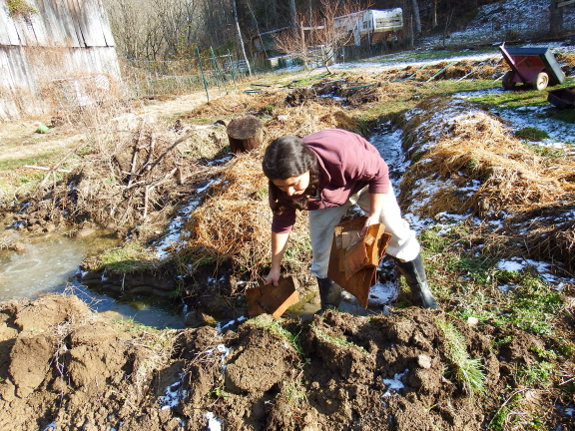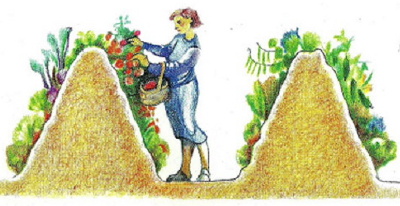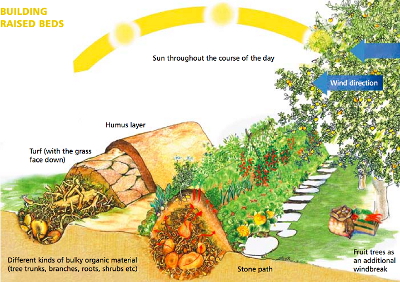
Very tall raised beds

I've been making lots of raised beds that are a bit like Sepp Holzer's
tall hugelkultur mounds lately, although only some have had wood
inside. These mounds are my current method of raising the root zone out
of the very high groundwater in two sectors of our garden. Despite what
some gardeners have tried to tell me, even water-loving vegetables like
tomatoes and watermelons have shriveled and died when there's only an
inch or two of drained soil to spread their roots through. So I dig out
the aisles and build the beds up.
My tall mounds definitely
solve the waterlogging problem, but they do present challenges of their
own. In the photo at the top of this post, I'm actually taking apart a
kill mulch rather than putting one together. Try as we might, Kayla and I
couldn't get the cardboard and feed bags to stay put atop this tall
bed, so I'll just mulch without the kill layer and weed out any grasses
that try to pop up through. The smart solution would have been to kill
mulch this area to remove lawn grasses before I dug the area into raised beds, but...twenty-twenty hindsight, right?
 The
other problem with my tall raised beds is that I'm often gardening in
knee boots, and it's impossible to run a lawnmower through the
waterlogged aisles. On the plus side, the local frog population adores
the wetlands I created, and after Lucy transfered duckweed from our sky pond, the aisles actually started turning into rather biologically diverse pondlets.
The
other problem with my tall raised beds is that I'm often gardening in
knee boots, and it's impossible to run a lawnmower through the
waterlogged aisles. On the plus side, the local frog population adores
the wetlands I created, and after Lucy transfered duckweed from our sky pond, the aisles actually started turning into rather biologically diverse pondlets.
So, in the long run, tall
mounds have become my favorite solution for dealing with very high
groundwater, although I might tweak the technique a bit by adding
drainage into more sky ponds in the future. However, I'm not sure I'd
recommend tall hugelkultur mounds if you're not trying to raise your
root zone up out of the wet. In a less rainy climate than ours, the tall
mounds would dry out on top pretty quickly (although the rotting lumber
would mitigate that in a few years once the wood broke down), and the
mulching problem would only be exacerbated if we ever saw wind. Plus,
it's hard to get your precious compost to stay put on a bed that's
mounded up to the soil's angle of repose, so you definitely see more
erosion with this technique than with the shallower, flat-topped beds I
use in other parts of the garden. But if you farm in a swamp like we do,
by all means, mound that ground up!
Want more in-depth information? Browse through our books.
Or explore more posts by date or by subject.
About us: Anna Hess and Mark Hamilton spent over a decade living self-sufficiently in the mountains of Virginia before moving north to start over from scratch in the foothills of Ohio. They've experimented with permaculture, no-till gardening, trailersteading, home-based microbusinesses and much more, writing about their adventures in both blogs and books.
Want to be notified when new comments are posted on this page? Click on the RSS button after you add a comment to subscribe to the comment feed, or simply check the box beside "email replies to me" while writing your comment.
- Remove comment

